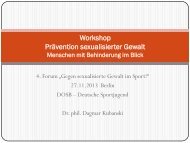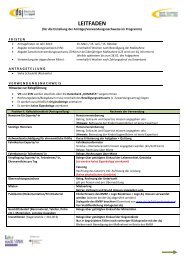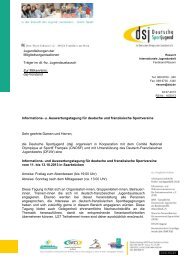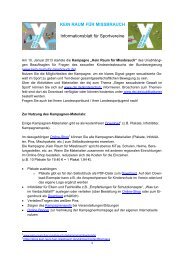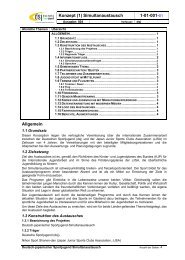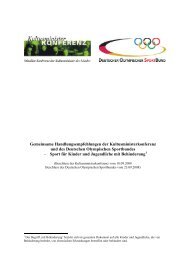Sexual harassment
Sexual harassment
Sexual harassment
Create successful ePaper yourself
Turn your PDF publications into a flip-book with our unique Google optimized e-Paper software.
What do we know about<br />
sexual <strong>harassment</strong> and<br />
abuse in sport in Europe<br />
Professor Kari Fasting (kari.fasting@nih.no)<br />
Norwegian School of Sport Sciences<br />
Key note speech presented at The European conference<br />
“Safer, better, stronger! Prevention of <strong>Sexual</strong> Harassment<br />
and Abuse in Sport<br />
Berlin, 20-21 November, 2012
• What are we talking about –<br />
defintions<br />
• Why is it so difficult to<br />
research and study<br />
• What do we know about:<br />
• The prevalence<br />
• The consequences<br />
• The risk factors<br />
• The perpetrators<br />
Outline
Central in most definitions of sexual<br />
<strong>harassment</strong> and abuse is that the<br />
behavior experienced is:<br />
• Unwanted<br />
• Threatening<br />
• Troublesome<br />
• Insulting<br />
• Offensive<br />
• Coherced/Forced<br />
• Abuse of Power
Identifying Gender Gender, , <strong>Sexual</strong> Harassment and<br />
Abuse<br />
• Gender <strong>harassment</strong> refers to a broad range of verbal and nonverbal<br />
behaviours not aiming at sexual cooperation but conveying insulting,<br />
hostile, and degrading attitudes about one gender (male or female),<br />
• <strong>Sexual</strong> <strong>harassment</strong> refers to behaviour towards an individual or<br />
group that involves sexualised verbal, non-verbal or physical<br />
behaviour, whether intended or unintended, legal or illegal, that is<br />
based upon an abuse of power and trust and that is considered by<br />
the victim or a bystander to be unwanted or coerced.<br />
• Common for definitions of sexual abuse is that it is non-consensual<br />
sexual contact and that it is forced or coerced. <strong>Sexual</strong> abuse involves<br />
any sexual activity where consent is not or cannot be given.
Examples of gender- , sexual <strong>harassment</strong> and abuse<br />
• Verbal<br />
• Derogatory or demeaning jokes and comments of a sexual nature<br />
• Repeated unwanted sexual proposals or invitations concerning<br />
sexual behavior<br />
• Ridicule or sexist jokes about women in general<br />
• Non-verbal<br />
• Unwanted sexual suggestions, whistling, sexual staring and leering<br />
about one’s body, clothes or private life<br />
• Unwanted telephone calls, sms or letters with sexual content<br />
• Being shown pictures or things with unwanted sexual content<br />
• Physical<br />
• Unwanted touching of a sexual nature,<br />
• pinching<br />
• attempted kissing<br />
• unwanted body contact and body pressing<br />
• Forced into sexual acts<br />
• Attempted rape and rape
<strong>Sexual</strong> exploitation continuum (Adapted from<br />
Brackenridge 1997)<br />
The spectrum<br />
SEX DISCRIMINATION<br />
"the chilly climate”<br />
e.g. worse pay, facilities or<br />
coaching for one sex<br />
bystanding<br />
GENDER & SEXUAL HARASSMENT<br />
"unwanted attention”<br />
e.g. sexual ridicule, jokes,<br />
stalking, bullying, homophobic<br />
taunts<br />
<strong>Sexual</strong> <strong>harassment</strong><br />
Gender <strong>harassment</strong><br />
Trans <strong>harassment</strong><br />
Homophobia<br />
SEXUAL ABUSE<br />
I N S T I T U T I O N A L ............…………………...……………………P E R S O N A L<br />
"groomed or coerced”<br />
e.g. sexual violence, assault,<br />
rape, sexual favors, groping,<br />
incest<br />
Grooming<br />
Hazing<br />
<strong>Sexual</strong> abuse
Process of<br />
Grooming/persuasion<br />
The process of grooming can be said to be the tool the<br />
abuser may employ to gain a position from which to carry<br />
out the abuse. The process of grooming and/or coercing<br />
someone for sexual abuse means that one slowly gains the<br />
trust of a person before systematically breaking down<br />
interpersonal barriers. The young athletes can become<br />
trapped, because his or her compliance is assured by using<br />
threats such as being cut from the team and/or giving or<br />
withholding privileges (Bringer et al 2002).
Prevalence<br />
Prevalence: : <strong>Sexual</strong> <strong>harassment</strong> and abuse in<br />
sport<br />
• SH varies between 14 - 73 %<br />
• SA varies between 2-22 %<br />
(Tomlinson and Yorganci 1997, Klein,<br />
M. & Palzkill, B. 1998), Cense &<br />
Brackenridge 2001, Brackenridge<br />
1997, Feigin and Hageby 2001,<br />
Brackenridge & Fasting 2008,<br />
Toftegård Nielsen 1998, 2004,<br />
Fasting & Knorre 2005, Jolly &<br />
Décamps (2006)., Gündüz et al 2007,<br />
Vanden Auweele et al 2008, Chroni &<br />
Fasting 2009, Alexander et al 2011,<br />
Hartill 2011, Fasting et al 2000, 2003,<br />
2004, 2011, 2012,.<br />
• Belgium<br />
• Czech Republic<br />
• Denmark<br />
• France<br />
• Germany<br />
• Greece<br />
• Netherlands<br />
• Norway<br />
• Turkey<br />
• UK
Female athletes’experiences of<br />
sexual <strong>harassment</strong> in sport (Fasting et<br />
al 2000, Fasting & Knorre 2005)
Forms of sexual <strong>harassment</strong><br />
and abuse from a coach<br />
• “… when we didn’t perform well, then the<br />
punishment was that we should sit on his lap. I<br />
remember I thought it was disgusting. He touched<br />
us and was really very disgusting. I don’t<br />
understand today that we accepted it at all. We<br />
had a drill where we had to sprint, and the one<br />
who came last had to sit on his lap, so everyone<br />
was running like hell…” (Fasting et al 2002)
Forms of sexual <strong>harassment</strong><br />
and abuse from a coach<br />
• “It happens quite often that people try to hug<br />
people, but with this particular coach it is very<br />
clear that it was in a sexual context, so you have<br />
to be really insistent to keep him away from<br />
yourself. I experienced it as unpleasant…..It<br />
mainly happens during the training where he<br />
uses opportunities like when someone is coming<br />
to practice and he comes to hug and says I’m<br />
really glad to see you. But during the hug he can<br />
move his hands on the body, which is<br />
unpleasant.” (Fasting and Knorre 2005)
<strong>Sexual</strong> <strong>harassment</strong> and abuse<br />
seems to occur in all sports
The experiences of children participating in organised<br />
sport in the UK. London: NSPCC. (Alexander, Stafford<br />
and Lewis 2011) N= 6000<br />
• Experiences of sexual<br />
<strong>harassment</strong>: 29 %<br />
• Experiences of sexual<br />
behaviour and sexual<br />
harm (abuse): 3 %
Czech female athletes’ experiences of<br />
sexual <strong>harassment</strong> in sport for different<br />
sport groups (Fasting & Knorre 2005)<br />
60<br />
50<br />
40<br />
30<br />
20<br />
10<br />
0<br />
55 % 44 %<br />
30 %<br />
Elite Non-elite Exercisers
The experiences of children participating in<br />
organised sport in the UK. London: NSPCC.<br />
(Alexander, Stafford and Lewis 2011) N= 6000<br />
Forms of SHA Women Men<br />
<strong>Sexual</strong> <strong>harassment</strong> 34% 17%<br />
<strong>Sexual</strong> abuse 2 % 5 %<br />
-----------------------------<br />
-------<br />
Non-physical SH<br />
-----------------------------<br />
------<br />
73 %<br />
-----------------------------<br />
-------<br />
58 %<br />
Physical SH 33 % 38 %
<strong>Sexual</strong> <strong>harassment</strong> from men inside sport<br />
experienced by female sport students in<br />
Czech Republic, Greece, and Norway
European female sport students<br />
experiences of sexual <strong>harassment</strong> in<br />
sport and education (Fasting et al. 2012)<br />
SH from male coach<br />
17,8 %<br />
SH from males in sport<br />
33,5 %<br />
SH from male athlete<br />
22,6 %<br />
SH from males in sport<br />
and/or in education<br />
50,5 %<br />
SH from male teacher<br />
17,0 %<br />
SH from males in<br />
education<br />
38,0 %<br />
SH from male student<br />
• 28,7 %<br />
28,7 %
Key messaging:<br />
the power of the coach<br />
• There seems to be a higher prevalence of sexual<br />
<strong>harassment</strong> experiences from coaches among athletes<br />
who have experienced authoritarian behaviors compared<br />
to athletes that have not had such coaches<br />
• Authoritarian coaching behavior is characterized by<br />
negative feedback, screaming, rough language, directive<br />
communication, coach-led decision making, taskcentered<br />
role orientation and goal oriented performance<br />
• One of the characterstics of authoritarian coaching is<br />
therefore the risk of overlooking and intruding on the<br />
needs and wills of the athletes since the atlethe is left out<br />
of important processes in the relationship. (Sand et al<br />
2011)
What is the impact of experiences of sexual<br />
<strong>harassment</strong> in a sport setting? setting<br />
• Drop out/leave sport<br />
? (Fasting Fasting et al 2002)<br />
• Damaged coach-athlete relationship and changes in behavior<br />
towards the coach<br />
• Difficult to concentrate when the harasser was around<br />
• Feelings of anger, irritability, confusion, and anxiety<br />
• Negative effects on self-esteem and body image<br />
• Changes in behavior towards other men and other coaches<br />
• Decline in practice and performance<br />
• Decreased satisfaction with one’s performance<br />
• Decreased self-confidence in relation to one’s sport’s skill<br />
• Decreased motivation for participating<br />
• A negative effect on the relationship to teammates
Risk Factors - Athletes<br />
• Poor relationship with their parents so the perpetrator has a chance to get<br />
close to the victims:<br />
• especially on tours,<br />
• during massage,<br />
• at the coach’s home and<br />
• during drives to and from practice<br />
• affords the coach complete control of her life<br />
• is totally dedicated to the coach or authority figure who assumes the status of<br />
a father figure<br />
• When athletes are unaware of their rights and those that work with them do<br />
not know how to identify indicators of <strong>harassment</strong> and abuse or what to do<br />
when they are concerned<br />
• They are at pre-peak performance level and dependent on coaches and their<br />
entourages for success, team selection, are more likely to be away from home
Selected risks factors factors- Sports<br />
(Brackenridge 2001, Fasting 2011 2011)<br />
The organizational structure<br />
• involves an hierarchical status<br />
system<br />
• gives rewards based on<br />
performance<br />
• has no formal procedures for<br />
screening, hiring and monitoring staff<br />
• technical/task demands legitimate<br />
touch<br />
• there is no guidance about expected<br />
standards of behavior such as codes<br />
of conduct and ethics<br />
• there are no mechanisms for<br />
athletes and others to report<br />
concerns or to have them responded<br />
to, i.e. there is a lack of protection,<br />
such as protection policies and<br />
procedure, education and training<br />
The organizational culture<br />
• Cultures of tolerance to<br />
homophobia and gender<br />
<strong>harassment</strong> exist unchallenged<br />
• has an autocratic authority system<br />
• involves close personal contact<br />
with athletes<br />
• sets up clear power imbalance<br />
between athlete and coach<br />
• gives scope for separation of<br />
athlete from peers in time and<br />
space<br />
• involves mixed sexes and ages<br />
sharing room on away trips



